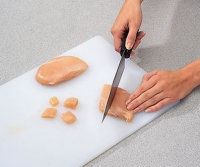Once you have determined the kind of chicken you wish to buy for your next chicken recipe, check out these important tips on inspecting and purchasing chicken safely and confidently.
- Check the package for the U.S.D.A. Grade A rating; chicken in most supermarkets should be government inspected. Look for secure, unbroken packaging, as well as a "sell-by" date stamp that indicates the last day the chicken should be sold.
- Physically inspect the chicken before purchasing. Its skin should be creamy white to deep yellow; meat should never look gray or pasty. Odors could signal spoilage. If you notice a strong, unpleasant odor after opening a package of chicken, leave it open on the counter for a few minutes. Sometimes oxidation takes place inside the package, resulting in a slight but harmless odor. If the odor remains, do not use the chicken. Return it in its original package to the store for a refund.
Having bought your chicken, you need to follow proper procedures for storing and handling it at home. To keep your family safe and healthy, it is important to use good judgment and sound food safety guidelines.
Advertisement
